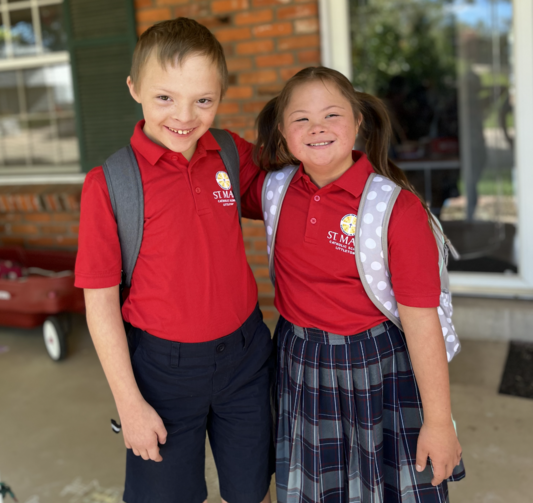If you ask the fifth-graders at St. Mary’s School, they’ll tell you that the luckiest kid in their class is the boy who sits next to my daughter Pia.
When I first heard that, I was surprised.
At home, Pia rarely sits still for long. She interrupts people to tell complicated stories or jokes— many of which are quite funny, but which don’t always come at the right time. When she gets bored, she says so, and then she insists on moving on, to do whatever she regards as more interesting than you.
Pia has Down syndrome.
She’s sweet, my daughter, and I love her. She has a big heart, great comedic timing and a sense of self-confidence I often envy.
In fact, I’m sometimes self-conscious on Pia’s behalf—more than I should be—which is why I wondered whether conscientious students would really be keen to sit next to her in class.
But Pia, to her great delight, is immensely popular at St. Mary’s School. So is her brother Max, who also has Down syndrome.
Their great personalities are not the only reason they are beloved.
They’re known and loved and valued because their school has made a decision to include them, and other children with disabilities, as full and active participants in their classrooms.
In fact, our parish school has decided that welcoming children with significant disabilities is an important part of its Catholic identity and a big part of forming all children to be disciples of Jesus Christ.
That is not always the case. While the Catholic Church has long been an outspoken voice for the rights and dignity of people with disabilities—encouraging parents of disabled children to choose life—those same children have often been excluded from Catholic schools. In most Catholic schools, parents like us have long been told that the cost of educating our children would be too great, or that public schools are better equipped for their formation.
It wasn’t long ago that parents at our parish were told the same thing.
But that’s changed. A few years ago, our principal and pastor decided the benefits were worth the challenges. They decided that the school exists to serve all parish families—including families like mine. And they decided that if they really wanted to talk convincingly about a “culture of life,” they had to actually build one in their classrooms.
There have been fits and starts—successes and unexpected challenges. But including students with disabilities has changed a lot about our school culture. Children like mine demonstrate that it’s O.K. to be different, that it’s O.K. to ask for help—and that there is joy in depending on each other to live our Christian vocations.
Their presence combats the atomizing and isolating tendencies of technocratic modernity. They model that interdependence should be the ordinary experience of Christ’s church. And they witness to the fact that while utilitarian anthropology might have a claim on American culture, the Catholic vision of the human person doesn’t tie dignity to productive capacity.
My children learn a lot from their peers, and they teach them a lot, too.
The boy who sits next to my daughter makes sure that she knows what page the class is reading from, and when it’s her turn to read aloud. In turn, she reminds him that a homogenized world is less rich—and less hope-filled—than one which is accommodating to difference.
From each other, I hope, they learn something about what real Christian communion actually looks like—and that the church has a real and living preferential option for the solidarity of friendship with people on the margins.
Our school’s commitment to including children like mine is somewhat rare. But across the country, that is changing. Advocates for the inclusion of disabled children in Catholic schools are making headway. Some bishops are emphasizing that people with disabilities belong in the church. And just two years ago, Pope Francis told people with disabilities that “the church is your home — and urged ecclesial leaders to make that promise a reality.
Of course, it is expensive to educate children with disabilities in Catholic schools. Teachers often lack training. Administrators often lack experience. And parents often have expectations that are unrealistic.
Inclusion works when there is a partnership among people of good will—parents, administrators, teachers and pastors. It works better when diocesan schools offices provide resources and guidance on tough questions, like toileting policies or adapting curricula.
And it works only when the whole Catholic community is willing to make the financial sacrifices required to tell each child—whatever his needs—that he has a place in a Catholic school, that the church really is his home.
In our local community, we’ve helped in recent years to build a non-profit that gives grants to parish schools for the inclusion of children with special needs. We have been edified by the support of a broad swath of Catholics — from every ecclesial and political tribe — who believe that Catholic schools should be a place for children with serious disabilities and needs.
The U.S. bishops’ conference, this year, is working to revise its 1978 “Pastoral Statement on Disabilities.”
As the bishops work, I hope they will challenge one another to offer people with disabilities more than platitudes and pro-life sloganeering. I hope they will commit to welcoming people with disabilities more generously in their parishes and other institutions. I hope they will say that children like mine should always have a place in Catholic schools.
Of course, if they haven’t seen inclusive special Catholic education done well, the bishops may have trouble envisioning it. They might not even believe it’s possible. If that’s the case, I hope they will come to St. Mary’s for a tour and observe a class or two.
They can even grab a desk next to Pia. I’m told that’s where the lucky kids sit.








